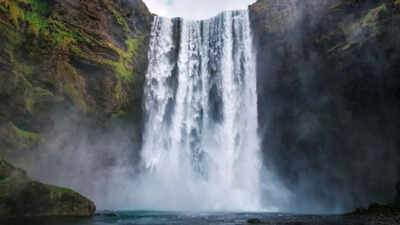ARTICLE AD BOX

For decades, the title of the world’s tallest waterfall belonged to Venezuela’s Angel Falls. But now, scientists are pointing to an even more colossal cascade — one that plunges a staggering 11,500 feet.
The twist? It’s completely invisible to the human eye. Located deep beneath the ocean’s surface between Greenland and Iceland, the Denmark Strait cataract is the largest waterfall on Earth — and no one will ever witness it in person. This underwater marvel moves over 3.2 million cubic meters of water per second, far more than any river on land. Yet its existence remained unknown until scientists began studying ocean temperatures, salinity, and currents in this icy part of the Atlantic.
What makes Denmark Strait the world's largest waterfall and why it’s invisible
The Denmark Strait cataract is an undersea waterfall formed where cold, dense water from the Nordic Sea meets warmer, lighter water from the Irminger Sea. This dramatic temperature and salinity difference causes the heavier water to plunge downward in a massive cascade beneath the ocean surface. First identified through thermal and salinity mapping, this phenomenon doesn’t roar or mist like terrestrial waterfalls.
Instead, it silently flows through the darkness, shaped by a submerged ridge left behind by glaciers during the Last Ice Age approximately 11,500 years ago.In sheer height and volume, it surpasses all known waterfalls. Niagara Falls measures about 181 feet, and Angel Falls 3,212 feet, but the Denmark Strait cataract plunges nearly four times deeper. Its hidden nature makes it one of the most fascinating and powerful forces in Earth's ocean systems.
A hidden force that regulates Earth's climate
Beyond its jaw-dropping size, the Denmark Strait cataract plays a critical role in maintaining global climate stability. As the cold Arctic water descends into the Atlantic, it powers the Atlantic Meridional Overturning Circulation (AMOC), a massive oceanic conveyor belt that distributes heat and nutrients across the world’s oceans. This deep-sea flow moderates temperatures in Europe, sustains marine biodiversity, and drives large-scale weather patterns.But the system is fragile. Climate change and warming Arctic waters are threatening the delicate balance of temperature and salinity that keeps this waterfall flowing. A disruption could weaken AMOC, raising ocean temperatures, intensifying hurricanes, and shifting climate zones worldwide. Marine scientists already see early signs of impact, such as the weakening of winter winds along the Catalan coast.Out of sight, yet incredibly influential, the world's largest waterfall is a silent engine behind the rhythms of Earth’s climate.



.png)
.png)
.png)
















 12 hours ago
5
12 hours ago
5









 English (US) ·
English (US) ·